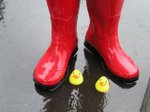 I thought I knew Alice Munro. It's a critical error, I think, so common amongst those of us who've been to school. Because we've read Lives of Girls and Women, and we've read The Stone Angel, and The Handmaid's Tale, so this CanLit thing is old hat, right? But I had no idea. I'd read The Progress of Love ages ago, though I don't even remember it, but it still lives on my shelf. I read Lives of Girls... at least twice in my literary schooling, and evaluated numerous undergraduate papers on Who Do You Think You Are? (which, in spite of that, remained a book I love).
I thought I knew Alice Munro. It's a critical error, I think, so common amongst those of us who've been to school. Because we've read Lives of Girls and Women, and we've read The Stone Angel, and The Handmaid's Tale, so this CanLit thing is old hat, right? But I had no idea. I'd read The Progress of Love ages ago, though I don't even remember it, but it still lives on my shelf. I read Lives of Girls... at least twice in my literary schooling, and evaluated numerous undergraduate papers on Who Do You Think You Are? (which, in spite of that, remained a book I love).I thought I knew Alice Munro, but that was like thinking I knew somebody I hadn't called up in twenty years. And then I picked up Alice Munro's Best: Selected Short Stories.
It wasn't clear from the start that I was wrong, for the first two stories "Royal Beatings" and "The Beggar Maid" were from Who Do You Think Are?, and so this was quite familiar ground. The next few stories followed similar patterns, the retrospective voice recalling a rural childhood and noting complicating factors the child's perspective had missed. There are hints of sexual transgression, domestic dissatisfaction, marriages go wrong, and whole ways of life now obliterated. All very much what I had expected.
The first real hint of something came with "Miles City Montana", which wasn't so much a departure from what had come before, but whose plot twist was so harrowing I had to skip right to the end before reading through. Keeping in mind, the is a short story. And the stories from then on in contained these singular horrifying moments where I could hardly bear to read. When one friend takes another's lover, a lonely librarian duped by the promise of love, characters that do terrible things to one another for reasons that are never straightforward or explainable. That taxidermist, and what he did behind Bea's back. The woman who's heading west, tricked into thinking she's promised love. The woman alone in her house in the country and the knock on her door in the middle of the night, or the woman driving with her grandchildren in the backseat when a filthy girl strung out on drugs forces her way into the car.
From "Friend of My Youth", the stories branch out into history, or least further back into history than Munro has been considering all along. Here, no more first person narration, but rather we get pieces from all manner of perspectives. The author herself revoking her own authority-- from the end of "Menesetung: "I thought there wasn't anybody alive in the world but me who would know this, who would make the connection. And I would be the last person to do so. But perhaps this isn't so. People are curious..../ And they may get it wrong, after all. I may have got it wrong. I don't know if she ever took laudanum. Many ladies did. I don't know if she ever made grape jelly."
These stories take on a strange, uncertain and fascinating shape. I was most struck by "Carried Away", which told the story of a small town librarian who receives unexpected letters from a soldier at war. Rather than a flowing narrative, the story is made up of blocks like a quilt, or more like sides of a cube because the result is most three-dimensional. I kept noticing points in these stories where the edges of these blocks would nearly connect, but not exactly-- slightly altered phrasing, or memory from a different angle. How lives are made, these stories are, with shady corners and lots of questions.
But then these really aren't stories at all, in a way, but rather novels. There is no narrow scope here, anything left out suggests reams of detail we can fill in for ourselves, and these are the stories of whole lives, entire places, which is not usually within the short story's grasp. They are not novels only because they're too short to be novels, which is not be undermine Alice Munro's status as the short story master, because I've never been so mesmerized by 500 pages of stories in my life. She is a master, I think, because in observing these stories written over the course of her career, it is evident that she's pushed the very limits of the form, changed the shape into something altogether different from what she started with, enabling the story to be stuffed to its capacity, and even further. An Alice Munro story: I didn't know the half of it. I'm still blown away.
This collection is enhanced by its introductory essay by Margaret Atwood, placing these stories within their literary and geographical context. I would have appreciated dates attached to each story, however, and their places of publication, to give an indication of the book's overall range. Also some kind of afterward by Munro herself, a retrospective? But then I fear I may be asking too much. With this superb collection, she has already given generously.

